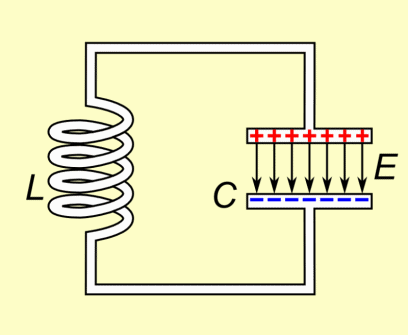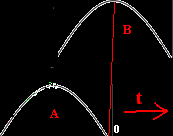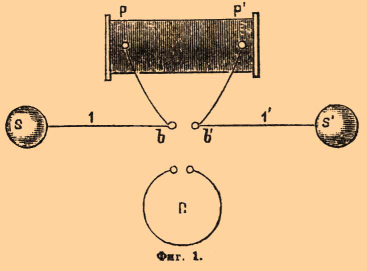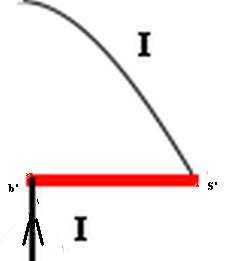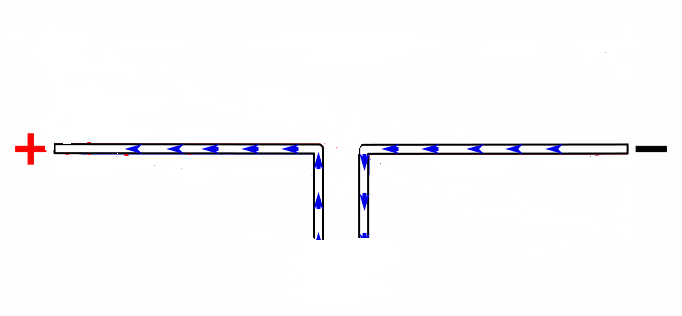...continued
|
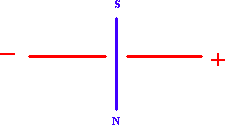
Figure-5a |

Figure-5b |
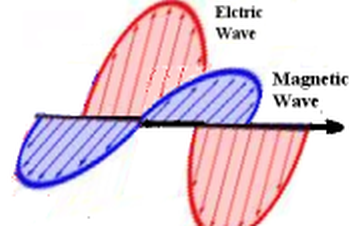
Figure-6
For the sake of visualizing the ongoing process, in real-time in the unfrozen dynamic state, it would be best to describe the waves movement as "walking" in a straight line from the transmitting antenna to the receiving one, rather than traveling or propagating in space.
The two waves are in motion forward by regenerating each other continuously for each step. The little friendly guy would like to demonstrate how it's done

How does the outcome of electromagnetic waves from Maxwell's equations stack up in this race?
2. Left in the dust ...

Figure-7a |
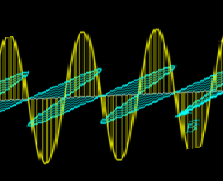
Figure-7b |
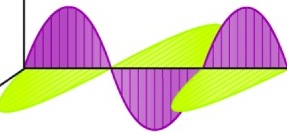
Figure-7c |
The problem with these images is that the magnetic and the electric waves they portray are in-phase (i.e., their wave crest coincides along the timeline). Such electromagnetic "waves" are, in fact, STATIC in nature; they aren't self-regenerating and, hence, unable to travel in space in the first place. (Despite being shown in these presentations as "traveling waves" by means of sophisticated animated images:
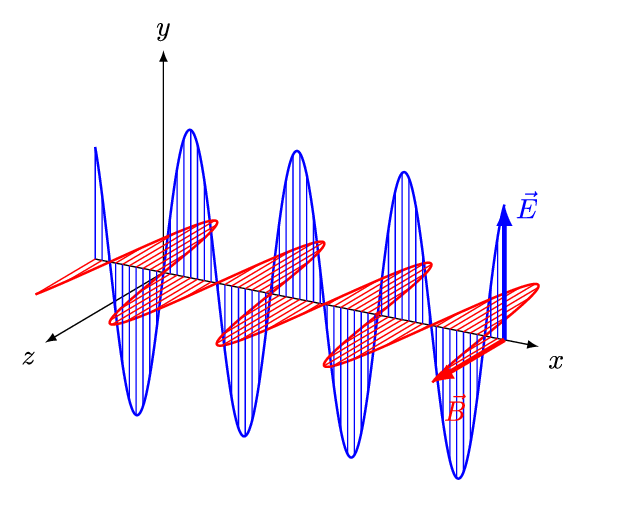 ).
).

Figure-8a |

Figure-8b |
The waves in Figure-7a,7b and 7c as they are, imply that Maxwell's equations are wanting. Given the above description, they are also quite redundant for explaining how a space-traveling electromagnetic wave is generated. But that is not all ...
According to Maxwell, a vector that is leaving the transmitting antenna, is the same as the one arriving at the far distant receiving antenna. Nothing can be further from the truth when it comes to the real world. A major radio transmission station is known to have emited a form of power which is equivalent to hundreds of kilowatts (if not megawatts), while the voltage which was produced on the distant receiving antenna is, at best, only in the millivolts (if not microvolts).
Evidently, Maxwell's theory proposes vectors with no magnitude. Should his theory be more inclusive and incorporate additional basic elements such as, for example, Coulomb's law, it may have beefed-up his vectors also with magnitude. It would, perhaps, enable them to portray a more realistic outcome. (Conceivably, his theory could have clarified that light is a quanta-packet of energy in the form of a wave and avoided the everlasting controversy of it being one or the other.)
Yet, there is remaining little debt to be paid to Maxwell.
3. Aristotle and his housefly
Maxwell's equations are often described as being an object of intimidation to engineering students due to the math they command for proper interpretation of their meaning. From my recollection of those days, math was not the problem. This sort of math was done routinely, in those days.The difficulty was to visualize a space-generated electromagnetic wave from the way these equations are presented even after, formally, going through with the mathematical process. It took a considerable amount of imagination and self-persuasion to convince oneself that, indeed, one could see a wave emerging. Because not being able to see waves moving could be taken as a lack of understanding of Maxwell's equations, and that could present a problem.
Aristotle allegedly declared, at some point, that the housefly has eight legs. The entire academia of that day, had to go through a lot of self-convincing to "confirm" that, indeed, they are all able to see eight legs on a fly. If there happened to be a freshman who claimed to see only six legs, he was promptly expelled for the reason that, not being able to see eight legs, is a clear indication that this person doesn't have what it takes to pursue academic studies.
I am sorry, Mr. Maxwell, I see only six legs.
Having cleared my debt to Maxwell for "helping me to realize" a speeding electromagnetic wave in space, there is still debt in arrears history owing to Hertz.
4. Hertz and his antenna
Where there is a need to transfer energy that is circulating in the LC circuit to become a traveling electromagnetic wave, a designer will reach for an antenna tuned to the circuit's frequency. It's far from being trivial, but it's based on a well-established practice. Hertz did not have this advantage, as there was no precedence for what he was attempting to accomplish. He had to figure out how to divert a wave, which is moving in space within the LC circuit, to move in space out of the circuit.It's worthwhile to review, at this point, what was said above regarding the LC circuit causing a shift forward in time. It said that it, actually, "caused a move forward in space-time". But, does the LC circuit-generated wave that, as seen, is advancing in time, also move in space? Yes, it does! It moves in the space of the capacitor, though, it's confined within between the parallel plates in there. That clarifies the dilemma Hertz was facing. How do you release the wave from this confinement?
Well, he "opens up" the capacitor and "spreads" it all over his antenna. It was nothing short of a stroke of genius on the part of Hertz to realize that an antenna would do the trick.
Many wrongly assume that the antenna is nothing but another form of LC circuit. Hertz's antenna is not an LC circuit, nor is it one of its elements. It constitutes a unique element of its own. It's tuned to be in resonance with the frequency, it's being fed, not by changing its "capacitance" or "inductance", but by the length of its conductors to match a quarter of the wavelength of this frequency.
Hertz's antenna can, however, be looked upon as a virtual "LC circuit" for the sake of understanding its operation. There is no physical capacitor in it, only a virtual one. The two extreme points of the electrical charge of the antenna conductors substituting for the parallel plates of this "capacitor". The entire space around the antenna is, in fact, the space of this virtual capacitor. This space extends all over up to any receiving antenna far away. A traveling electromagnetic wave, through this "capacitor's space", is, therefore, able to reach receiving antennas situated anywhere all over the globe and beyond.
A more direct way of explaining this is to look at the operation of a "newly" invented device called an antenna. This device is capable of generating and mutually regenerating magnetic and electric waves continuously (as seen in figures 4, 5a and 5b above). These waves are continually advancing in space-time. Since there is nothing that prevents them from moving forward in space, they do so, as demonstrated above (by the little guy).
Isn't it a great invention?
This should never have been belittled, as these kinds of events that eventually change the world (such as the invention of the wheel, the invention of the saddle-stirrups or, the invention of the printing-press) occur very seldom. The closest that comes to mind, in more modern times, is the case with Tesla.
An engineering gifted student, by the name of Tesla, is attending a demonstration of a direct-current motor in operation, where the motor's commutator produces a captious amount of sparks. He, instantly, perceives a multiphase alternating-current rotating magnetic field, where motors and generators turn at asynchronous speed, with no commutators. It eventually materialized into the electrical distribution system the world knows today.
The same Tesla, though way older, got an idea to apply Hertz's antenna to some esoteric and bizarre development projects with unrealistic prospects ... But this story is for another day ... (I am badly digressing here as is.)
Hertz couldn't possibly use Maxwell's equations as an instruction manual to build his experimental setup more then their prediction for obtaining his discovery. Despite the prevailing version of the sequence of events, it looks like he did his work with no reference at all to Maxwell's equations.
In his own words: "... I based my first interpretations of these experiments [electromagnetic propagation] upon the older views ", (i.e., on the electromagnetic original basic laws and their mutual interactions, not on Maxwell's theory); and he adds: "To Maxwell's theory in its pure development such a distinction [the cooperation of electrostatic and electromagnetic forces] is foreign."
He goes on in saying: "... propagation of electrostatic force, which, indeed, is meaningless in Maxwell's theory ... understanding of Maxwell's theory [is] more difficult partly for no other reason than that they really posses no meaning ..."
It appears that, in all likelihood, it was Hertz's actual findings that preceded Maxwell's prediction. In other words, it was, probably, after Hertz's discovery that people (and, indeed, Hertz himself) went back to see if they could make Maxwell's equations establish a moving electromagnetic wave in space. Quoting Hertz: "Hence I now wish to show that the phenomena [electromagnetic waves] can be explained in terms of Maxwell's theory ..."
Not getting his idea from Maxwell, one may still wonder if perhaps Hertz come upon his discovery in serendipity. However, there is another, generally, unrecognized point which proves Hertz's full awareness of the ongoing in this work.
Throughout his various experimental setups, Hertz consistently terminated his antenna length with conductive-spheres, as seen in Figure-3 S and S'.
What are these spheres doing here? It was known at that time that a conductor's sharp-edge is the cause for losing some electrical-charge due to bleeding to the surrounding space (in particular where, relatively, high charged conductors are concerned).
Franklin specified a sharp-edge to his lightning-arrester in order to readily attract an electrical charge from the clouds. It was done for the same reason that Hertz did, but for a contrasting function. Franklin's sharp-edge caused high-concentration of electrical charge (high-voltage) and, hence, high-attractive force in the surrounding space.
The opposite to a sharp-edge is a very-blunt and a smote-edge. A conductive-sphere fits the bill best. It, clearly, suggest that Hertz, being aware of this problem, put these spheres in order to facilitate and optimized the functioning of his antenna.
Modern forms of transmitting-antennas are often fitted out with similar extensions (known as: Top-Hates) in order to compensate for these antennas being, physically, too short from a true quarter of wavelength. However, these antennas, more often then not, having sharp-edges to their extensions which defeats the purpose of maximizing the radiation efficiency of these antennas.
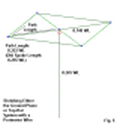
|
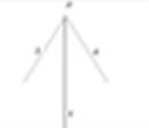
|
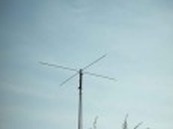
|
History owes Hertz an apology for relegating him to footnotes as: "the person who just confirmed in practice Maxwell's prediction". The irony is that Hertz did not think much of his discovery. (But then, Hertz should be remembered "only" as a great inventor, not necessarily as a great visionary.)
It still required a genuine visionary to realize that a mere lab curiosity could turn into what is now known as "radio". Enter Marconi.
5. Hertzian's waves versus Marconigrams
Every book on the subject of the history of radio, in the western world, asserts that Marconi is the inventor of the radio (the Russians have their own "inventor of the radio"). Marconi was a visionary and an entrepreneur (and perhaps also a minor inventor) who recognized the potential of the Hertzian's waves.(Instead of using the term: "electromagnetic waves that travel in space and that comprise electric and magnetic waves and ..." etc., these waves were, most appropriately, termed at that time as Hertzian's waves, a term which ought to endure.)
Marconi established telegraph stations with, basically, hertz's experimental setup (with some minor modifications and improvements). These stations, successfully, substituted for the long-haul wired-based telegraph stations of that time. It was a major step in the way to all-encompass worldwide wireless telecommunications. Furthermore, it enabled even ships to communicate wirelessly. It could have averted the Titanic tragedy if not for human failure... But I'm digressing here once more...
Marconi's enterprise turned out to be success. The messages sent worldwide were termed "Marconigrams" (strangely enough, this name didn't last. A message, eventually, was called a "cable" even though it was sent via wireless).
Marconi initiated an era where the use of radio became a convention. But, is that a sufficient reason to make him the "inventor of the radio"?
Marconi was not the inventor of the radio, Hertz is!
6. Hertz's antenna and Columbus' egg
The quintessential skeptic may maintain that Maxwell's equations constitute solid mathematics and are a powerful tool for designers of telecommunications systems. Also, the radio is more than just an antenna set up by Hertz. Besides, this antenna is just a piece of wire, something which could have been done by anybody and, indeed, was done.Quite so! Arguments are well taken. The mathematics used in Maxwell's equations is very powerful for calculations of all sorts of waves, such as water waves and sound waves, not just electromagnetic waves that are ... Hum ... Hertzian's waves.
(By the way, these waves were never termed "Maxwellian's waves". Shouldn't it be the case if Maxwell's "prediction" came first?)
However, Maxwell did not invent these mathematics. He wasn't even the one who formulated his equations in the way they are presented today. This was done by others, based on Maxwell's theory.
Maxwell's equations do not propose any new laws of nature. Apart from the prediction they imply (assuming, of course, that this so-called "prediction" can at least be presented correctly), they do not reveal any discovery. All they do is restate in mathematical form some of the electromagnetics laws which were, otherwise, already well-known and well-described.
The design of the WI-FI for your cellphone has not been facilitated by the use of these equations. It appears that the only use of the equations is to serve as a good exercise for engineering students to practice their mathematical abilities to solve theoretical and hypothetical problems.
The antenna is, in essence, a piece of wire. But, it's not just that. It's also the heart and soul of radio. It's the sole component of radio where the waves are conceived and heralded out in space. Sure, later models of radios would have oscillators, amplifiers, modulators, detectors, filters, and mixers, as well as, vacuum-tubes and transistors. But, these and similar more, are mere accessories for improving the operation of the radio and extending its function to applications way beyond just telecommunication. Clearly, they are not essential for basic functioning. Marconi operated radio systems all over the world, with only Hertz teaching without any of those accessories.
Indeed, anybody can set up an antenna easily. But only after having shown how. It takes only somebody, short of a genius, to figure out how to do it in the first place. It reminds the case of Columbus and his egg ... Ho no! I am not going there! But... I just remembered the part played by the most influential spark.
7. The vanishing spark everlasting mojo
A transmitter's LC-circuit, of that era, required to have an opening-gap in it, which was continually switched on and off by means of a spark. It was the only possible way to stimulate the LC-circuit into operation at the time.In addition to the role of feeding the antenna, points b and b' of Hertz's experimental set-up in Figure-3, had the double role of being switched on and off by means of that spark which was visible during the transmitter operation.
A space-propagating electromagnetic-wave leaving a transmitting antenna eventually ends-up at a receiving one. But, how is it be verified that a wave is indeed being picked-up while a radio receiver, of some sort, is yet to be developed?
Hertz's solution was to have the receiving antenna bent into a circle so that it formed a small gap between its ends (as seen at the bottom of Figure-3). Since the circle was in close proximity to the transmitting antenna, it resulted in a high enough voltage to be induced in it for a spark to ignite in the gap.

OOPS... Just a demonstration of the idea ... I would shy
away from holding the ring in bare-hands while in operation!
(Can you say: "heart defibrillation"?)
The spark in the receiving antenna constituted an explicit proof of the existence of space-propagating electromagnetic-waves. Important as it was, the spark part didn't just end there. It also has been given full credit for the entire process.
It appeared that the visible spark at the transmitting antenna ended up at the receiving one and it gave the impression that the two separate sparks are, actually, one and the same.
It was concluded that the spark some how migrated from the transmitting antenna to the receiving one through space. There was a blind-belief that the spark accomplished the whole "transaction" by itself with no outside help (the role of the electrical circuit which generated the spark was unrecognized and completely ignored).
Since it was not possible to have a simple explanation how it transpired (based on basic-physics) it resorted to Maxwell's treatise for this "explanation".
Eventually, sparks vanished from LC-circuits due to progress in technology. It's puzzling, and somewhat disturbing to think that this belief persists presently, even though a transmitting equipment of any kind, nowadays, has no sparks in it (better not!).
With my apologies to Maxwell for toppling him down the pedestal he perched on for all these years,
Joel Tepper, P.Eng.
telejt

